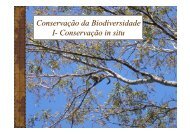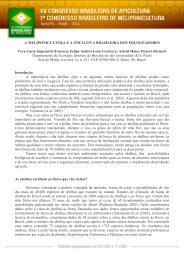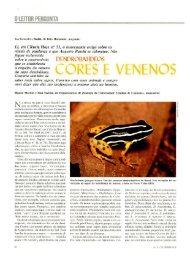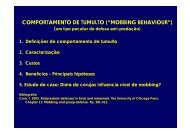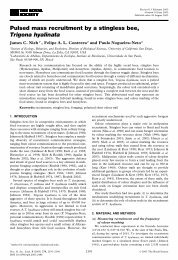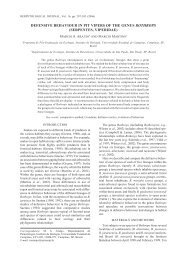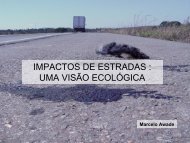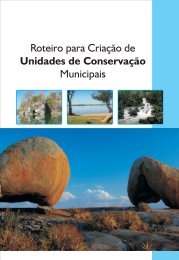a new insular species of pitviper from brazil, with comments on ...
a new insular species of pitviper from brazil, with comments on ...
a new insular species of pitviper from brazil, with comments on ...
Create successful ePaper yourself
Turn your PDF publications into a flip-book with our unique Google optimized e-Paper software.
September 2002] HERPETOLOGICA<br />
303<br />
Herpetologica, 58(3), 2002, 303–312<br />
2002 by The Herpetologists’ League, Inc.<br />
A NEW INSULAR SPECIES OF PITVIPER FROM BRAZIL, WITH<br />
COMMENTS ON EVOLUTIONARY BIOLOGY AND<br />
CONSERVATION OF THE BOTHROPS JARARACA GROUP<br />
(SERPENTES, VIPERIDAE)<br />
OTAVIO A. V. MARQUES 1 ,MARCIO MARTINS 2,4 , AND IVAN SAZIMA 3<br />
1<br />
Laboratório de Herpetologia, Instituto Butantan, 05535-900 São Paulo SP, Brazil<br />
2<br />
Departamento de Ecologia, Instituto de Biociências, C. P. 11461, Universidade de São Paulo, 05422-970<br />
São Paulo SP, Brazil<br />
3<br />
Departamento de Zoologia and Museu de História Natural, C. P. 6109, Universidade Estadual de<br />
Campinas, 13083-970 Campinas SP, Brazil<br />
ABSTRACT: We describe a <str<strong>on</strong>g>new</str<strong>on</strong>g> <str<strong>on</strong>g>pitviper</str<strong>on</strong>g> <str<strong>on</strong>g>species</str<strong>on</strong>g>, Bothrops alcatraz, <str<strong>on</strong>g>of</str<strong>on</strong>g> the Bothrops jararaca<br />
group, <str<strong>on</strong>g>from</str<strong>on</strong>g> Alcatrazes Island, <str<strong>on</strong>g>of</str<strong>on</strong>g>f the coast <str<strong>on</strong>g>of</str<strong>on</strong>g> São Paulo, southeastern Brazil. It differs <str<strong>on</strong>g>from</str<strong>on</strong>g> the<br />
mainland coastal populati<strong>on</strong>s <str<strong>on</strong>g>of</str<strong>on</strong>g> B. jararaca in southeastern Brazil mostly by its darker colorati<strong>on</strong>;<br />
smaller size; lower number <str<strong>on</strong>g>of</str<strong>on</strong>g> ventrals, subcaudals, and infralabials; number and shape <str<strong>on</strong>g>of</str<strong>on</strong>g> anterior<br />
cephalic scales; shape <str<strong>on</strong>g>of</str<strong>on</strong>g> hemipenis spines; intense coagulant activity <str<strong>on</strong>g>of</str<strong>on</strong>g> venom; and three specific<br />
venom proteins. From Bothrops <str<strong>on</strong>g>insular</str<strong>on</strong>g>is, another island <str<strong>on</strong>g>species</str<strong>on</strong>g> <str<strong>on</strong>g>from</str<strong>on</strong>g> southeastern Brazil, the <str<strong>on</strong>g>new</str<strong>on</strong>g><br />
<str<strong>on</strong>g>species</str<strong>on</strong>g> differs mainly by its color pattern, smaller size, lower number <str<strong>on</strong>g>of</str<strong>on</strong>g> subcaudals in males, and<br />
absence <str<strong>on</strong>g>of</str<strong>on</strong>g> hemiclitoris in females. Bothrops alcatraz presents some features that may be viewed as<br />
paedomorphic <str<strong>on</strong>g>with</str<strong>on</strong>g>in the B. jararaca group, such as small adult size, proporti<strong>on</strong>ally large eyes,<br />
intense coagulant venom activity, and diet composed <str<strong>on</strong>g>of</str<strong>on</strong>g> centipedes and lizards. We postulate that<br />
the dwarfism and characteristics <str<strong>on</strong>g>of</str<strong>on</strong>g> venom in B. alcatraz may be related to its diet (similar to that<br />
<str<strong>on</strong>g>of</str<strong>on</strong>g> juveniles <str<strong>on</strong>g>of</str<strong>on</strong>g> the mainland B. jararaca). Bothrops alcatraz and B. <str<strong>on</strong>g>insular</str<strong>on</strong>g>is may have originated<br />
through the isolati<strong>on</strong> <str<strong>on</strong>g>of</str<strong>on</strong>g> populati<strong>on</strong>s <str<strong>on</strong>g>of</str<strong>on</strong>g> a B. jararaca-like ancestor <strong>on</strong> the Alcatrazes and Queimada<br />
Grande islands, respectively. The <str<strong>on</strong>g>new</str<strong>on</strong>g> <str<strong>on</strong>g>species</str<strong>on</strong>g> is regarded as critically endangered due to its very<br />
small area <str<strong>on</strong>g>of</str<strong>on</strong>g> occurrence and the declining quality <str<strong>on</strong>g>of</str<strong>on</strong>g> its habitat.<br />
Bothrops alcatraz; Crotalinae; Evoluti<strong>on</strong>; Island endemics; Natural history; South-<br />
Key words:<br />
eastern Brazil<br />
THE SYSTEMATICS <str<strong>on</strong>g>of</str<strong>on</strong>g> snakes <str<strong>on</strong>g>of</str<strong>on</strong>g> the genus<br />
Bothrops is notoriously difficult (Campbell<br />
4 CORRESPONDENCE: e-mail, jararaca@ib.usp.br<br />
and Lamar, 1989; Hoge and Romano-<br />
Hoge, 1981; Werman, 1992), although several<br />
<str<strong>on</strong>g>species</str<strong>on</strong>g> groups have been recognized<br />
recently (Cadle, 1992; Gutberlet, 1998;
304 HERPETOLOGICA<br />
[Vol. 58, No. 3<br />
Salomão et al., 1997, 1999; Werman,<br />
1992). The genus is probably paraphyletic<br />
(see Gutberlet, 1998; Parkins<strong>on</strong>, 1999),<br />
and comprises about 40 <str<strong>on</strong>g>species</str<strong>on</strong>g> including<br />
those previously allocated in Bothriopsis<br />
(Gutberlet, 1998; Parkins<strong>on</strong>, 1999; Salomão<br />
et al., 1997, 1999; Vidal et al., 1999).<br />
Members <str<strong>on</strong>g>of</str<strong>on</strong>g> two groups <str<strong>on</strong>g>of</str<strong>on</strong>g> Bothrops occur<br />
<strong>on</strong> coastal islands <strong>on</strong> southeastern Brazil.<br />
Snakes related to Bothrops jararaca<br />
(Wied), including Bothrops <str<strong>on</strong>g>insular</str<strong>on</strong>g>is<br />
(Amaral), are known <str<strong>on</strong>g>from</str<strong>on</strong>g> several islands<br />
<str<strong>on</strong>g>of</str<strong>on</strong>g> various sizes and distances <str<strong>on</strong>g>from</str<strong>on</strong>g> the<br />
coast (up to about 35 km), ranging <str<strong>on</strong>g>from</str<strong>on</strong>g><br />
Franceses Island <str<strong>on</strong>g>of</str<strong>on</strong>g>f Espírito Santo (latitude<br />
about 21 00 S) south to Santa Catarina<br />
Island (latitude about 27 30 S),<br />
whereas Bothrops jararacussu (Lacerda) is<br />
more restricted in its distributi<strong>on</strong> and occurs<br />
mainly <strong>on</strong> larger islands close to the<br />
coast <str<strong>on</strong>g>of</str<strong>on</strong>g> São Paulo (1 km <str<strong>on</strong>g>from</str<strong>on</strong>g> the mainland;<br />
Amaral, 1921a; Duarte et al., 1995;<br />
Luederwaldt and F<strong>on</strong>seca, 1923; pers<strong>on</strong>al<br />
observati<strong>on</strong>). Island populati<strong>on</strong>s <str<strong>on</strong>g>of</str<strong>on</strong>g> snakes<br />
are good subjects for evoluti<strong>on</strong>ary studies,<br />
especially when compared to their generally<br />
widespread mainland relatives (e.g.,<br />
Forsman, 1991; Schwaner, 1985). These<br />
populati<strong>on</strong>s also deserve special attenti<strong>on</strong><br />
for c<strong>on</strong>servati<strong>on</strong> as they generally occur<br />
exclusively in very restricted areas (e.g., 43<br />
ha in the case <str<strong>on</strong>g>of</str<strong>on</strong>g> B. <str<strong>on</strong>g>insular</str<strong>on</strong>g>is, Duarte et al.,<br />
1995).<br />
The B. jararaca group comprises two<br />
<str<strong>on</strong>g>species</str<strong>on</strong>g> (Salomão et al., 1999), the widespread<br />
B. jararaca, probably a complex <str<strong>on</strong>g>of</str<strong>on</strong>g><br />
several <str<strong>on</strong>g>species</str<strong>on</strong>g> (Salomão et al., 1997), and<br />
the <str<strong>on</strong>g>insular</str<strong>on</strong>g> endemic B. <str<strong>on</strong>g>insular</str<strong>on</strong>g>is. The latter<br />
<str<strong>on</strong>g>species</str<strong>on</strong>g> is restricted to Queimada Grande<br />
Island, <str<strong>on</strong>g>of</str<strong>on</strong>g>f the coast <str<strong>on</strong>g>of</str<strong>on</strong>g> São Paulo, southeastern<br />
Brazil (Campbell and Lamar,<br />
1989). Herein, we describe a sec<strong>on</strong>d <str<strong>on</strong>g>insular</str<strong>on</strong>g><br />
<str<strong>on</strong>g>pitviper</str<strong>on</strong>g> <str<strong>on</strong>g>species</str<strong>on</strong>g> <str<strong>on</strong>g>from</str<strong>on</strong>g> Brazil, first collected<br />
in 1914 and previously referred to<br />
the widespread <str<strong>on</strong>g>species</str<strong>on</strong>g> B. jararaca (e.g.,<br />
Luederwaldt and F<strong>on</strong>seca, 1923).<br />
MATERIALS AND METHODS<br />
We examined 24 specimens <str<strong>on</strong>g>of</str<strong>on</strong>g> the <str<strong>on</strong>g>new</str<strong>on</strong>g><br />
<str<strong>on</strong>g>insular</str<strong>on</strong>g> <str<strong>on</strong>g>species</str<strong>on</strong>g> and 39 specimens <str<strong>on</strong>g>of</str<strong>on</strong>g> B. jararaca<br />
<str<strong>on</strong>g>from</str<strong>on</strong>g> adjacent c<strong>on</strong>tinental populati<strong>on</strong>s<br />
<str<strong>on</strong>g>of</str<strong>on</strong>g> coastal São Paulo (Appendix I) in<br />
the collecti<strong>on</strong> <str<strong>on</strong>g>of</str<strong>on</strong>g> Instituto Butantan (IB)<br />
and Museu de História Natural da Universidade<br />
Estadual de Campinas (ZUEC).<br />
For each snake, we measured the snout–<br />
vent length (SVL) and tail length (TL) to<br />
the nearest 1 mm <str<strong>on</strong>g>with</str<strong>on</strong>g> a flexible rule.<br />
Head length (HL; <str<strong>on</strong>g>from</str<strong>on</strong>g> snout to extreme<br />
posterior part <str<strong>on</strong>g>of</str<strong>on</strong>g> mandible) and eye diameter<br />
(ED) were measured <str<strong>on</strong>g>with</str<strong>on</strong>g> a caliper<br />
to the nearest 0.1 mm; to compare HL and<br />
ED between <str<strong>on</strong>g>species</str<strong>on</strong>g>, we divided HL by<br />
the ‘‘trunk’’ length (TR SVL HL) and<br />
ED by HL. Mass (to the nearest 1 g) was<br />
obtained <str<strong>on</strong>g>with</str<strong>on</strong>g> spring scales after draining<br />
the excess preservative liquid through ventral<br />
incisi<strong>on</strong>s; to compare mass between<br />
<str<strong>on</strong>g>species</str<strong>on</strong>g>, we divided mass by total length<br />
(TTL). Descripti<strong>on</strong> and scale counts follow<br />
Campbell (1985). We c<strong>on</strong>sidered the first<br />
ventral as being the first scale wider than<br />
l<strong>on</strong>g. Additi<strong>on</strong>ally, we counted the anterior<br />
cephalic scales (i.e., the total number <str<strong>on</strong>g>of</str<strong>on</strong>g><br />
cephalic scales, including the intersupraoculars)<br />
to the tip <str<strong>on</strong>g>of</str<strong>on</strong>g> the snout. Hemipenial<br />
ornamentati<strong>on</strong> names follow Dowling<br />
and Savage (1960). Color names follow<br />
Kornerup and Wanscher (1961). Data for<br />
B. <str<strong>on</strong>g>insular</str<strong>on</strong>g>is in Table 1 are <str<strong>on</strong>g>from</str<strong>on</strong>g> Amaral<br />
(1921a). Data <strong>on</strong> microhabitat use, feeding,<br />
and reproducti<strong>on</strong> were obtained during<br />
fieldwork and by examining preserved<br />
specimens in museum collecti<strong>on</strong>s.<br />
The populati<strong>on</strong> <str<strong>on</strong>g>of</str<strong>on</strong>g> <str<strong>on</strong>g>pitviper</str<strong>on</strong>g>s inhabiting<br />
Alcatrazes Island is well differentiated<br />
<str<strong>on</strong>g>from</str<strong>on</strong>g> both populati<strong>on</strong>s <str<strong>on</strong>g>of</str<strong>on</strong>g> snakes occurring<br />
in Queimada Grande Island (B. <str<strong>on</strong>g>insular</str<strong>on</strong>g>is)<br />
and <strong>on</strong> adjacent mainland (B. jararaca).<br />
After carefully analyzing the morphological<br />
and ecological attributes <str<strong>on</strong>g>of</str<strong>on</strong>g> the Alcatrazes<br />
<str<strong>on</strong>g>pitviper</str<strong>on</strong>g>, we c<strong>on</strong>cluded that the Alcatrazes<br />
Island populati<strong>on</strong> represents a<br />
distinctive <str<strong>on</strong>g>species</str<strong>on</strong>g> that may be known as:<br />
Bothrops alcatraz sp. nov.<br />
Holotype.—IB 62545 (Fig. 1), male<br />
<str<strong>on</strong>g>from</str<strong>on</strong>g> Alcatrazes Island (24 06 S, 45 42<br />
W), São Sebastião, São Paulo State, Brazil,<br />
15 December 1999, collected by O. A. V.<br />
Marques, M. Martins, M. E. Oliveira, D.<br />
N. Pereira and A. Martensen.<br />
Paratypes.—Eighteen specimens, all<br />
<str<strong>on</strong>g>from</str<strong>on</strong>g> the type locality: MZUSP 1453, October<br />
1920, collected by H. Luederwaldt;<br />
ZUEC 2224, male, 22 March 2000, col-
September 2002] HERPETOLOGICA<br />
305<br />
FIG. 1.—Bothrops alcatraz type locality and two specimens in situ. Alcatrazes Island photographed <str<strong>on</strong>g>from</str<strong>on</strong>g> a<br />
nearby islet <str<strong>on</strong>g>with</str<strong>on</strong>g> two brown boobies in foreground (upper left); the Atlantic forest <strong>on</strong> Alcatrazes Island (upper<br />
right); holotype (IB 62545), showing gaping behavior and seabird droppings <strong>on</strong> the head (lower left); male<br />
(IB 62290) showing body proporti<strong>on</strong>s, dorsal pattern, and seabird droppings scattered <strong>on</strong> the adjacent ground<br />
(lower right). Photos <str<strong>on</strong>g>of</str<strong>on</strong>g> the island by F. P. de Campos.<br />
lected by M. Martins, R. Sawaya, M. E.<br />
Oliveira, D. N. Pereira, A. Martensen and<br />
O. A. V. Marques; ZUEC 2225, female, 24<br />
March 2000, collected by O. A. V.<br />
Marques; IB 584 male, IB 585 female, IB<br />
586 female, IB 587 female, and IB 588<br />
female, June 1914, collected by A. A. Gomes;<br />
IB 13032, female, February 1950,<br />
collected by Instituto Butantan expediti<strong>on</strong>;<br />
IB 13135 female, 1950, collected by Instituto<br />
Butantan expediti<strong>on</strong>; IB 16211 and IB<br />
16212 both females, 7 January 1955, collected<br />
by F. Witaker; IB 55579 male, 14<br />
December 1992, collected by W. Langeani;<br />
IB 55580, female, April 1992, collected<br />
by M. Bu<strong>on</strong><strong>on</strong>ato; IB 55791 male,<br />
16 April 1994, collected by A. Eterovic; IB<br />
57105, male, 2 December 1996, collected<br />
by S. Sant’anna; IB 57107, female, 17 June<br />
1994, collected by Instituto Butantan expediti<strong>on</strong>;<br />
IB 62238, female, 15 December<br />
1999, collected by O. A. V. Marques, M.<br />
Martins, M. E. Oliveira, D. N. Pereira,<br />
and A. Martensen.<br />
Referred specimens.—Six specimens<br />
<str<strong>on</strong>g>from</str<strong>on</strong>g> the type locality: IB 13031 male, IB<br />
13126 male, and IB 13183 female, February<br />
1950, Instituto Butantan expediti<strong>on</strong><br />
coll.; IB 55578 male, December 1992, W.<br />
Langeani coll.; IB 55581 male, 24 January<br />
1992, W. Langeani coll.; IB 56133 female,<br />
1994, Instituto Butantan expediti<strong>on</strong> coll.<br />
Diagnosis.—The <str<strong>on</strong>g>new</str<strong>on</strong>g> <str<strong>on</strong>g>species</str<strong>on</strong>g> is superficially<br />
similar to B. jararaca <str<strong>on</strong>g>from</str<strong>on</strong>g> coastal<br />
São Paulo, <str<strong>on</strong>g>from</str<strong>on</strong>g> which it may be distinguished<br />
by the following combinati<strong>on</strong> <str<strong>on</strong>g>of</str<strong>on</strong>g><br />
characters (B. jararaca in parentheses):<br />
smaller adult size, mean male TTL 425.6<br />
32.5, range 365–462 mm (versus 801.6<br />
107.6 mm, range 378–924 mm); mean<br />
female TTL 455.7 41.4, range 365–505<br />
mm (versus 969.0 107.1, range 337–<br />
1080 mm); shorter tail, TL/SVL 0.161 <br />
0.007 (0.168 0.009) in males, 0.138
306 HERPETOLOGICA<br />
[Vol. 58, No. 3<br />
FIG. 2.—Heads <str<strong>on</strong>g>of</str<strong>on</strong>g> Bothrops alcatraz (paratypes IB 587 and IB 585, upper) and Bothrops jararaca (IB<br />
57903 and IB 58130, lower) in dorsal view showing variati<strong>on</strong> in scalati<strong>on</strong>. Line 5 mm.<br />
0.011 (0.144 0.012) in females; l<strong>on</strong>ger<br />
head, HL/TR 0.0053 0.0003 (0.0041 <br />
0.0002) in males, 0.0055 0.0003 (0.0045<br />
0.0010) in females; larger eyes, ED/HL<br />
0.157 0.010 (0.149 0.010) in males,<br />
0.154 0.009 (0.126 0.022) in females;<br />
32–50, 37.5 4.2, anterior cephalic scales<br />
generally rounded and <str<strong>on</strong>g>with</str<strong>on</strong>g> no or feeble<br />
keels (32–64, 47.0 8.2, generally el<strong>on</strong>gate<br />
and distinctly keeled, Fig. 2); lower<br />
number <str<strong>on</strong>g>of</str<strong>on</strong>g> infralabials usually 10/10 (usually<br />
11/11); lower number <str<strong>on</strong>g>of</str<strong>on</strong>g> ventrals, 173–<br />
186 (197–218); lower number <str<strong>on</strong>g>of</str<strong>on</strong>g> subcaudal<br />
scales in males 47–58 (62–72) and in females<br />
45–52 (53–68) (Table 1), and hemipenis<br />
spines relatively slender (stouter in<br />
B. jararaca) (Fig. 3). Additi<strong>on</strong>al characters<br />
that distinguish B. alcatraz <str<strong>on</strong>g>from</str<strong>on</strong>g> B. jararaca<br />
are the presence in the former <str<strong>on</strong>g>of</str<strong>on</strong>g><br />
three venom proteins <str<strong>on</strong>g>with</str<strong>on</strong>g> molecular<br />
weights <str<strong>on</strong>g>of</str<strong>on</strong>g> 20, 40, and 60 kD, which do<br />
not occur in B. jararaca, and the intense<br />
coagulant activity <str<strong>on</strong>g>of</str<strong>on</strong>g> venom <str<strong>on</strong>g>of</str<strong>on</strong>g> adult B. alcatraz<br />
(M. F. D. Furtado, pers<strong>on</strong>al communicati<strong>on</strong>),<br />
a character that occurs <strong>on</strong>ly<br />
in juvenile B. jararaca (Furtado et al.,<br />
1991). From B. <str<strong>on</strong>g>insular</str<strong>on</strong>g>is, the <str<strong>on</strong>g>new</str<strong>on</strong>g> <str<strong>on</strong>g>species</str<strong>on</strong>g><br />
is easily distinguished by color pattern and<br />
smaller size (Campbell and Lamar, 1989:<br />
Figs. 214 and 215), and lower number <str<strong>on</strong>g>of</str<strong>on</strong>g><br />
subcaudals in males (47–54 versus 55–65,<br />
respectively). An additi<strong>on</strong>al diagnostic<br />
character <str<strong>on</strong>g>of</str<strong>on</strong>g> B. <str<strong>on</strong>g>insular</str<strong>on</strong>g>is is presence <str<strong>on</strong>g>of</str<strong>on</strong>g> the<br />
hemiclitoris (cf. Ziegler and Böhme, 1997)<br />
in females. Furthermore, Bothrops alcatraz<br />
is known <strong>on</strong>ly <str<strong>on</strong>g>from</str<strong>on</strong>g> Alcatrazes Island,<br />
whereas B. <str<strong>on</strong>g>insular</str<strong>on</strong>g>is is known <strong>on</strong>ly <str<strong>on</strong>g>from</str<strong>on</strong>g><br />
Queimada Grande Island, and B. jararaca
September 2002] HERPETOLOGICA<br />
307<br />
TABLE 1.—Comparis<strong>on</strong> <str<strong>on</strong>g>of</str<strong>on</strong>g> selected characters <str<strong>on</strong>g>of</str<strong>on</strong>g> Bothrops alcatraz, coastal specimens <str<strong>on</strong>g>of</str<strong>on</strong>g> B. jararaca, and B.<br />
<str<strong>on</strong>g>insular</str<strong>on</strong>g>is. Measurements in mm, number <str<strong>on</strong>g>of</str<strong>on</strong>g> individuals in parentheses.<br />
Snout–vent length males<br />
Snout–vent length females<br />
Ventrals males<br />
Ventrals females<br />
Subcaudals males<br />
Subcaudals females<br />
Mid-body scale rows<br />
Intersupraoculars<br />
Anterior cephalics<br />
B. alcatraz B. jararaca* B. <str<strong>on</strong>g>insular</str<strong>on</strong>g>is**<br />
365–462 (10)<br />
365–505 (14)<br />
173–182 (10)<br />
175–186 (14)<br />
47–54 (10)<br />
45–52 (14)<br />
22–26 (24)<br />
6–8 (24)<br />
31–48 (24)<br />
Infralabials 10/10 (19); 10/11 (4);<br />
9/10 (1)<br />
Hemipenial spines<br />
Postorbital stripe<br />
* From coastal São Paulo.<br />
** Data <str<strong>on</strong>g>from</str<strong>on</strong>g> Amaral (1921a).<br />
stout<br />
present<br />
378–996 (15)<br />
320–1080 (24)<br />
200–211 (15)<br />
197–218 (19)<br />
62–72 (15)<br />
53–68 (19)<br />
21–27 (34)<br />
7–10 (34)<br />
31–64 (34)<br />
10/10 (6); 10/11 (5);<br />
9/11 (1); 11/11 (15);<br />
11/12 (4); 12/12 (2);<br />
12/10 (1)<br />
slender<br />
present<br />
393–788 (94)<br />
332–882 (106)<br />
171–188 (94)<br />
176–195 (106)<br />
55–65 (94)<br />
48–59 (106)<br />
23–25 (200)<br />
7–9 (203)<br />
—<br />
—<br />
—<br />
absent or faint<br />
is a widespread <str<strong>on</strong>g>species</str<strong>on</strong>g> in southeastern<br />
Brazil, both <strong>on</strong> the mainland and <strong>on</strong> some<br />
larger islands close to the coast (Campbell<br />
and Lamar 1989, pers<strong>on</strong>al observati<strong>on</strong>).<br />
Etymology.—The specific epithet is a<br />
noun in appositi<strong>on</strong> and refers to the local<br />
name <str<strong>on</strong>g>of</str<strong>on</strong>g> the frigate bird, Fregata magnificens<br />
(Pelecaniformes), whose col<strong>on</strong>ies <strong>on</strong><br />
the Alcatrazes Island give name to the type<br />
locality <str<strong>on</strong>g>of</str<strong>on</strong>g> the <str<strong>on</strong>g>new</str<strong>on</strong>g> <str<strong>on</strong>g>species</str<strong>on</strong>g>. We suggest the<br />
comm<strong>on</strong> name ‘‘Alcatrazes lancehead’’ for<br />
the <str<strong>on</strong>g>new</str<strong>on</strong>g> <str<strong>on</strong>g>species</str<strong>on</strong>g>.<br />
Descripti<strong>on</strong> <str<strong>on</strong>g>of</str<strong>on</strong>g> holotype.—An adult male<br />
(Fig. 1) preserved in ethanol <str<strong>on</strong>g>with</str<strong>on</strong>g> both<br />
hemipenes everted; SVL 448 mm; TL 72<br />
FIG. 3.—Asulcate side <str<strong>on</strong>g>of</str<strong>on</strong>g> right hemipenes <str<strong>on</strong>g>of</str<strong>on</strong>g> Bothrops<br />
alcatraz (paratype ZUEC 2225, left) an Bothrops<br />
jararaca (IB 62478, right) showing ornamentati<strong>on</strong>.<br />
Line 5 mm.<br />
mm, comprising 16.1% <str<strong>on</strong>g>of</str<strong>on</strong>g> total length; HL<br />
22.6 mm; maximum head width 15.1 mm;<br />
mass 53 g (preserved); rostral scute 3.6<br />
mm wide and 3.8 mm high; nasals divided<br />
anterior and posterior to nostril; loreal single;<br />
3/3 prefoveals; 1/1 subfoveals; 1/1<br />
post-foveals; prelacunal c<strong>on</strong>tacting the sec<strong>on</strong>d<br />
supralabial <strong>on</strong> the right side <str<strong>on</strong>g>of</str<strong>on</strong>g> the<br />
head, fused <str<strong>on</strong>g>with</str<strong>on</strong>g> it <strong>on</strong> the left side; 1/1<br />
suboculars; 2/2 preoculars; 2/2 postoculars;<br />
9/8 supralabials; 10/10 infralabials, first<br />
pair in c<strong>on</strong>tact posteriorly; mental l<strong>on</strong>ger<br />
than broad, c<strong>on</strong>tacting the first three infralabials<br />
<strong>on</strong> each side; five gulars between<br />
chin shields and first ventral; six rows <str<strong>on</strong>g>of</str<strong>on</strong>g><br />
gulars separating first ventral <str<strong>on</strong>g>from</str<strong>on</strong>g> infralabials;<br />
three anterior internasals; 2/2 canthals;<br />
5 posterior intercanthals; 6 intersupraoculars;<br />
34 cephalic scales <str<strong>on</strong>g>with</str<strong>on</strong>g> no or<br />
feeble keels <str<strong>on</strong>g>from</str<strong>on</strong>g> mid level <str<strong>on</strong>g>of</str<strong>on</strong>g> the intersupraoculars<br />
to the tip <str<strong>on</strong>g>of</str<strong>on</strong>g> snout (Fig. 2);<br />
25-25-19 dorsals; 177 ventrals; anal scute<br />
single; 57 subcaudals (proximal 54 divided<br />
and distal three undivided); five small<br />
scales <strong>on</strong> each side <str<strong>on</strong>g>of</str<strong>on</strong>g> the cloaca; tail spine<br />
three times as l<strong>on</strong>g as adjacent subcaudals,<br />
dorsal scales covering anterior half <str<strong>on</strong>g>of</str<strong>on</strong>g> tail<br />
spine.<br />
Dorsal scales 2.5 times as l<strong>on</strong>g as wide<br />
anteriorly, becoming wider posteriorly,<br />
about 1.5 times as l<strong>on</strong>g as wide <strong>on</strong> tail; all<br />
dorsal scales str<strong>on</strong>gly keeled; paraventral<br />
row <str<strong>on</strong>g>of</str<strong>on</strong>g> scales smooth to very weakly keeled
308 HERPETOLOGICA<br />
[Vol. 58, No. 3<br />
<strong>on</strong> posterior part <str<strong>on</strong>g>of</str<strong>on</strong>g> body, parasubcaudals<br />
noticeably keeled; paraventrals about twice<br />
as wide as adjacent dorsal scales; posterior<br />
cephalic scales str<strong>on</strong>gly keeled and l<strong>on</strong>ger<br />
than wide; anterior cephalic scales rounded,<br />
smooth to weakly keeled; temporal<br />
scales keeled; internasals, canthals, and supraoculars<br />
smooth; scale row dorsal to supralabials<br />
weakly keeled.<br />
Everted hemipenis subcylindrical, bilobed,<br />
extending to seventh subcaudal<br />
scale; bifurcati<strong>on</strong> <str<strong>on</strong>g>of</str<strong>on</strong>g> sulcus spermaticus at<br />
level <str<strong>on</strong>g>of</str<strong>on</strong>g> first subcaudal; sulcus extending to<br />
tip <str<strong>on</strong>g>of</str<strong>on</strong>g> each lobe; bifurcati<strong>on</strong> <str<strong>on</strong>g>of</str<strong>on</strong>g> lobes at level<br />
<str<strong>on</strong>g>of</str<strong>on</strong>g> sec<strong>on</strong>d subcaudal scale; small to large<br />
ossified spines assymetrically distributed<br />
<strong>on</strong> hemipenis extending <str<strong>on</strong>g>from</str<strong>on</strong>g> level <str<strong>on</strong>g>of</str<strong>on</strong>g> first<br />
subcaudal; largest spines about the same<br />
length as adjacent subcaudal scales; lobes<br />
covered <str<strong>on</strong>g>with</str<strong>on</strong>g> high retiform ridges forming<br />
papillate calyces (Fig. 3).<br />
Dorsum <str<strong>on</strong>g>of</str<strong>on</strong>g> head (in preservative)<br />
brownish gray <str<strong>on</strong>g>with</str<strong>on</strong>g> diffuse dark olivebrown<br />
markings. A prominent dark olivebrown<br />
postorbital stripe extending <str<strong>on</strong>g>from</str<strong>on</strong>g><br />
behind the eye to below the angle <str<strong>on</strong>g>of</str<strong>on</strong>g> the<br />
jaw, encroaching up<strong>on</strong> the posterior three<br />
supralabials <strong>on</strong> the right side <str<strong>on</strong>g>of</str<strong>on</strong>g> head and<br />
the posterior two scales <strong>on</strong> the left side;<br />
this stripe bordered dorsally by a diffuse<br />
pale brown z<strong>on</strong>e. Canthal regi<strong>on</strong> and supralabials<br />
uniform gray. Iris grayish yellow<br />
<str<strong>on</strong>g>with</str<strong>on</strong>g> darker flecking. Body brown gray<br />
<str<strong>on</strong>g>with</str<strong>on</strong>g> a series <str<strong>on</strong>g>of</str<strong>on</strong>g> 14 large, pale gray-edged,<br />
dark olive-brown trapezoidal markings <strong>on</strong><br />
each side, <str<strong>on</strong>g>with</str<strong>on</strong>g> their apices <strong>on</strong> the vertebral<br />
line; trapezoidal markings arranged<br />
opposite each other, or partly or completely<br />
juxtaposed; the pale borders <str<strong>on</strong>g>of</str<strong>on</strong>g> dark<br />
markings diffuse (Fig. 1). Tail dark brown<br />
dorsally. Venter pale yellowish gray <str<strong>on</strong>g>with</str<strong>on</strong>g> irregular<br />
brown blotching to flecking becoming<br />
more c<strong>on</strong>centrated <strong>on</strong> tail.<br />
Distributi<strong>on</strong>.—Known <strong>on</strong>ly <str<strong>on</strong>g>from</str<strong>on</strong>g> Alcatrazes<br />
Island (1.35 km 2 ), the largest <str<strong>on</strong>g>of</str<strong>on</strong>g> four<br />
small islands <str<strong>on</strong>g>of</str<strong>on</strong>g> Alcatrazes Archipelago<br />
(Fig. 1), approximately 35 km <str<strong>on</strong>g>from</str<strong>on</strong>g> the<br />
coast <str<strong>on</strong>g>of</str<strong>on</strong>g> São Paulo (Vanzolini, 1973),<br />
southeastern Brazil, <str<strong>on</strong>g>with</str<strong>on</strong>g> an elevati<strong>on</strong>al<br />
range <str<strong>on</strong>g>of</str<strong>on</strong>g> 3–266 m above sea level.<br />
Natural history.—We found the <str<strong>on</strong>g>new</str<strong>on</strong>g><br />
<str<strong>on</strong>g>species</str<strong>on</strong>g> active both <strong>on</strong> the ground (n 6)<br />
and <strong>on</strong> low vegetati<strong>on</strong> (n 5) <str<strong>on</strong>g>with</str<strong>on</strong>g>in the<br />
Atlantic forest covering Alcatrazes Island<br />
(semi-arboreal habits are characteristic<br />
<str<strong>on</strong>g>with</str<strong>on</strong>g>in the B. jararaca group: see Martins<br />
et al., 2002); the holotype was found <strong>on</strong><br />
the rocks <str<strong>on</strong>g>of</str<strong>on</strong>g> the wall <str<strong>on</strong>g>of</str<strong>on</strong>g> an old building<br />
(Fig. 1). Two individuals were resting by<br />
day, <strong>on</strong>e <str<strong>on</strong>g>with</str<strong>on</strong>g>in a decomposing palm trunk<br />
and the other under a fallen palm leaf. Of<br />
12 prey found in the guts <str<strong>on</strong>g>of</str<strong>on</strong>g> B. alcatraz,<br />
nine were otostigmine centipedes (Otostigmus<br />
sp.) and three were lizards (two introduced<br />
gekk<strong>on</strong>id lizards, Hemidactylus<br />
mabouia, and <strong>on</strong>e scincid, Mabuya macrorhyncha).<br />
Centipedes and H. mabouia<br />
are comm<strong>on</strong> <strong>on</strong> the low porti<strong>on</strong>s <str<strong>on</strong>g>of</str<strong>on</strong>g> tree<br />
and palm trunks, as well as <strong>on</strong> the walls <str<strong>on</strong>g>of</str<strong>on</strong>g><br />
old buildings. Most specimens <str<strong>on</strong>g>of</str<strong>on</strong>g> B. alcatraz<br />
were found under seabird (Sula leucogaster<br />
and Fregata magnificens) roosts<br />
<strong>on</strong> the canopy <str<strong>on</strong>g>of</str<strong>on</strong>g> the low forest, where<br />
large amounts <str<strong>on</strong>g>of</str<strong>on</strong>g> guano accumulate <strong>on</strong> the<br />
leaf litter (individuals <str<strong>on</strong>g>of</str<strong>on</strong>g> B. alcatraz are <str<strong>on</strong>g>of</str<strong>on</strong>g>ten<br />
found <str<strong>on</strong>g>with</str<strong>on</strong>g> bird droppings splashed<br />
over their body, Fig. 1). Cockroaches and<br />
centipedes (which probably prey <strong>on</strong> the<br />
former) are abundant <strong>on</strong> and around the<br />
guano. This is the <strong>on</strong>ly <str<strong>on</strong>g>species</str<strong>on</strong>g> <str<strong>on</strong>g>of</str<strong>on</strong>g> Bothrops<br />
known to feed mostly, if not exclusively, <strong>on</strong><br />
ectothermic prey (Martins et al., 2001).<br />
This prey type and the venom properties<br />
<str<strong>on</strong>g>of</str<strong>on</strong>g> B. alcatraz probably are related, as a<br />
relati<strong>on</strong>ship was found between the diet<br />
and venom compositi<strong>on</strong> for some Bothrops<br />
<str<strong>on</strong>g>species</str<strong>on</strong>g> and/or <strong>on</strong>togenetic phases<br />
(Andrade and Abe, 1999; Andrade et al.,<br />
1996; Furtado et al., 1991; M.F.D. Furtado,<br />
pers<strong>on</strong>al communicati<strong>on</strong>). Curiously,<br />
despite preying <strong>on</strong> lizards, neither juveniles<br />
(n 3) nor adults have whitish or<br />
otherwise c<strong>on</strong>spicuous tail tips, a feature<br />
present in all <str<strong>on</strong>g>species</str<strong>on</strong>g> <str<strong>on</strong>g>of</str<strong>on</strong>g> Bothrops known<br />
to prey <strong>on</strong> lizards or frogs, which are lured<br />
by the snake’s tail movements (Martins et<br />
al., 2001).<br />
Other snake <str<strong>on</strong>g>species</str<strong>on</strong>g> recorded <strong>on</strong> Alcatrazes<br />
Island are two colubrids, Dipsas albifr<strong>on</strong>s<br />
and Siphlophis pulcher, and an elapid,<br />
Micrurus corallinus, which also occur<br />
in the mainland Atlantic forest <str<strong>on</strong>g>of</str<strong>on</strong>g><br />
southeastern Brazil (Peters and Orejas-Miranda,<br />
1970). Species <str<strong>on</strong>g>of</str<strong>on</strong>g> Dipsas are arboreal<br />
but may forage <strong>on</strong> the ground and<br />
prey <strong>on</strong> slugs and snails. Siphlophis pulch-
September 2002] HERPETOLOGICA<br />
309<br />
er is arboreal and may also forage <strong>on</strong> the<br />
ground preying <strong>on</strong> lizards (including M.<br />
macrorhyncha and H. mabouia). Micrurus<br />
corallinus is fossorial and feeds <strong>on</strong> amphisbaenians<br />
and other el<strong>on</strong>gate reptile<br />
prey (Marques and Sazima, 1997; Sazima,<br />
1989; Sazima and Argôlo, 1994; pers<strong>on</strong>al<br />
observati<strong>on</strong>). Thus, <strong>on</strong>ly S. pulcher overlaps<br />
<str<strong>on</strong>g>with</str<strong>on</strong>g> B. alcatraz in food requirements.<br />
The smallest mature male (<str<strong>on</strong>g>with</str<strong>on</strong>g> opaque<br />
efferent ducts and enlarged testes) <str<strong>on</strong>g>of</str<strong>on</strong>g> B.<br />
alcatraz was 365 mm SVL and the smallest<br />
mature female (<str<strong>on</strong>g>with</str<strong>on</strong>g> oviductal embryos)<br />
was 477 mm SVL; males and females <str<strong>on</strong>g>of</str<strong>on</strong>g><br />
B. jararaca attain sexual maturity at about<br />
650 and 750 mm SVL, respectively (Janeiro-Cinquini<br />
et al., 1993; Sazima, 1992).<br />
Thus, individuals <str<strong>on</strong>g>of</str<strong>on</strong>g> Bothrops alcatraz attain<br />
sexual maturity at a much smaller size<br />
than individuals <str<strong>on</strong>g>of</str<strong>on</strong>g> B. jararaca. A female<br />
<str<strong>on</strong>g>of</str<strong>on</strong>g> B. alcatraz collected in December c<strong>on</strong>tained<br />
<strong>on</strong>e oviductal embryo and <strong>on</strong>e atresic<br />
vitellogenic follicle. The embryo was<br />
fully-developed (SVL 130 mm, TL 27<br />
mm). Another female collected in January<br />
c<strong>on</strong>tained two atresic vitellogenic follicles,<br />
apparently not ovulated. These data indicate<br />
that the period <str<strong>on</strong>g>of</str<strong>on</strong>g> juvenile recruitment<br />
in B. alcatraz may be similar to those<br />
<str<strong>on</strong>g>of</str<strong>on</strong>g> most <str<strong>on</strong>g>species</str<strong>on</strong>g> <str<strong>on</strong>g>of</str<strong>on</strong>g> Bothrops, in which parturiti<strong>on</strong><br />
occurs generally between January<br />
and May (Almeida-Santos and Salomão,<br />
2001; pers<strong>on</strong>al observati<strong>on</strong>). Fecundity in<br />
B. alcatraz may be low due to its small<br />
body size, a trend recorded for several<br />
snake <str<strong>on</strong>g>species</str<strong>on</strong>g> (e.g., Shine, 1994). Another<br />
island <str<strong>on</strong>g>species</str<strong>on</strong>g>, B. <str<strong>on</strong>g>insular</str<strong>on</strong>g>is, also shows a<br />
low fecundity (litters <str<strong>on</strong>g>of</str<strong>on</strong>g> 2–10 and a high<br />
frequency <str<strong>on</strong>g>of</str<strong>on</strong>g> atresic eggs: Hoge et al.,<br />
1959).<br />
DISCUSSION<br />
Available data <strong>on</strong> the natural history <str<strong>on</strong>g>of</str<strong>on</strong>g><br />
the three <str<strong>on</strong>g>species</str<strong>on</strong>g> <str<strong>on</strong>g>of</str<strong>on</strong>g> the B. jararaca group<br />
(see Sazima, 1992; Martins et al., 2001)<br />
suggest to us the following scenarios for<br />
diversificati<strong>on</strong> <str<strong>on</strong>g>with</str<strong>on</strong>g>in this group. Two populati<strong>on</strong>s<br />
<str<strong>on</strong>g>of</str<strong>on</strong>g> a B. jararaca-like ancestor became<br />
isolated in the past (see below) <strong>on</strong><br />
Queimada Grande and Alcatrazes islands.<br />
Small mammals, the main prey <str<strong>on</strong>g>of</str<strong>on</strong>g> adult B.<br />
jararaca (and <str<strong>on</strong>g>of</str<strong>on</strong>g> most Bothrops; Martins et<br />
al., 2001), do not presently occur <strong>on</strong> these<br />
islands and there is no evidence that they<br />
previously occurred there. Thus, <str<strong>on</strong>g>from</str<strong>on</strong>g> a<br />
semiarboreal, dietary generalist ancestor<br />
(Martins et al., 2001), two distinct evoluti<strong>on</strong>ary<br />
routes seem to have been taken by<br />
these two <str<strong>on</strong>g>insular</str<strong>on</strong>g> <str<strong>on</strong>g>species</str<strong>on</strong>g>. As a result <str<strong>on</strong>g>of</str<strong>on</strong>g> the<br />
absence <str<strong>on</strong>g>of</str<strong>on</strong>g> small mammals <strong>on</strong> the islands,<br />
adult B. <str<strong>on</strong>g>insular</str<strong>on</strong>g>is relied heavily <strong>on</strong> migrant<br />
passerine birds (approximately 85% <str<strong>on</strong>g>of</str<strong>on</strong>g><br />
their current diet; Martins et al., 2001),<br />
became more arboreal (Martins et al.,<br />
2001), and evolved a venom that kills birds<br />
more effectively (Amaral, 1921b; Cogo et<br />
al., 1993). On the other hand, adults <str<strong>on</strong>g>of</str<strong>on</strong>g> B.<br />
alcatraz retained two characters <str<strong>on</strong>g>of</str<strong>on</strong>g> juveniles,<br />
a diet based <strong>on</strong> ectotherms (present<br />
study) and venom compositi<strong>on</strong> (M.F.D.<br />
Furtado, pers<strong>on</strong>al communicati<strong>on</strong>). The<br />
isolati<strong>on</strong> <str<strong>on</strong>g>of</str<strong>on</strong>g> populati<strong>on</strong>s <str<strong>on</strong>g>of</str<strong>on</strong>g> the B. jararacalike<br />
ancestor <strong>on</strong> coastal islands <str<strong>on</strong>g>of</str<strong>on</strong>g> southeastern<br />
Brazil may have occurred during<br />
<strong>on</strong>e or more <str<strong>on</strong>g>of</str<strong>on</strong>g> the several oscillati<strong>on</strong>s <str<strong>on</strong>g>of</str<strong>on</strong>g><br />
sea level during the Pleistocene (Martin et<br />
al., 1986), the last <str<strong>on</strong>g>of</str<strong>on</strong>g> these occurring about<br />
11,000 yr ago (Rodrigues, 1990).<br />
The main prey <str<strong>on</strong>g>of</str<strong>on</strong>g> the two <str<strong>on</strong>g>insular</str<strong>on</strong>g> <str<strong>on</strong>g>species</str<strong>on</strong>g><br />
(birds and centipedes) occur in the diet <str<strong>on</strong>g>of</str<strong>on</strong>g><br />
almost all generalist <str<strong>on</strong>g>species</str<strong>on</strong>g> <str<strong>on</strong>g>of</str<strong>on</strong>g> Bothrops,<br />
including B. jararaca, although in much<br />
lower frequencies (Martins et al., 2001),<br />
and were likely already present in the diet<br />
<str<strong>on</strong>g>of</str<strong>on</strong>g> their B. jararaca-like ancestor. Thus,<br />
feeding mostly <strong>on</strong> ectothermic prey by B.<br />
alcatraz and <strong>on</strong> birds by B. <str<strong>on</strong>g>insular</str<strong>on</strong>g>is may<br />
be c<strong>on</strong>sidered as exaptati<strong>on</strong>s. A comprehensive<br />
study <str<strong>on</strong>g>of</str<strong>on</strong>g> the phylogeny and habits<br />
<str<strong>on</strong>g>of</str<strong>on</strong>g> the jararaca group, including other island<br />
populati<strong>on</strong>s al<strong>on</strong>g the coast <str<strong>on</strong>g>of</str<strong>on</strong>g> southeastern<br />
and southern Brazil, would provide<br />
useful tools for evaluating the hypotheses<br />
above.<br />
In general, resources <strong>on</strong> islands are in<br />
short supply, especially <strong>on</strong> small islands,<br />
and this may explain why mammals seldom<br />
col<strong>on</strong>ize these isolated habitats<br />
(McNab, 1994). On the other hand, ectotherms<br />
require lower levels <str<strong>on</strong>g>of</str<strong>on</strong>g> resource<br />
use and several reptiles are successful island<br />
col<strong>on</strong>izers (e.g., Case, 1983; Hasegawa<br />
and Morigushi, 1989). Well known examples<br />
<str<strong>on</strong>g>of</str<strong>on</strong>g> successful island col<strong>on</strong>izers<br />
am<strong>on</strong>g <str<strong>on</strong>g>pitviper</str<strong>on</strong>g>s include four <str<strong>on</strong>g>species</str<strong>on</strong>g> <str<strong>on</strong>g>of</str<strong>on</strong>g><br />
Bothrops in the Caribbean and in south-
310 HERPETOLOGICA<br />
[Vol. 58, No. 3<br />
eastern Brazil (Campbell and Lamar, 1989;<br />
Duarte et al., 1995; our study), Agkistrod<strong>on</strong><br />
piscivorus in coastal Florida (Whart<strong>on</strong>,<br />
1969), and several <str<strong>on</strong>g>species</str<strong>on</strong>g> <str<strong>on</strong>g>of</str<strong>on</strong>g> rattlesnakes<br />
(e.g., Case, 1983) in the New<br />
World, as well as Ovophis okinavensis<br />
(Morigushi, 1989) and Gloydius sheddaoensis<br />
(Jian-Li, 1995) in Asia. The generalist<br />
habits <str<strong>on</strong>g>of</str<strong>on</strong>g> most <str<strong>on</strong>g>pitviper</str<strong>on</strong>g>s (Greene,<br />
1992; Martins et al., 2001) may have greatly<br />
facilitated the col<strong>on</strong>izati<strong>on</strong> <str<strong>on</strong>g>of</str<strong>on</strong>g> islands by<br />
<str<strong>on</strong>g>species</str<strong>on</strong>g> <str<strong>on</strong>g>of</str<strong>on</strong>g> Bothrops and other <str<strong>on</strong>g>pitviper</str<strong>on</strong>g>s.<br />
Although body size am<strong>on</strong>g <str<strong>on</strong>g>species</str<strong>on</strong>g> <str<strong>on</strong>g>of</str<strong>on</strong>g> island<br />
snakes is highly variable (e.g., Case,<br />
1983; Schwaner, 1985), crotalines are generally<br />
smaller <strong>on</strong> islands (Case, 1983). Variati<strong>on</strong><br />
in body size in <str<strong>on</strong>g>insular</str<strong>on</strong>g> snakes may<br />
be a c<strong>on</strong>sequence <str<strong>on</strong>g>of</str<strong>on</strong>g> prey size and availability,<br />
as well as other factors such as<br />
presence or absence <str<strong>on</strong>g>of</str<strong>on</strong>g> predators and<br />
competitors (Case, 1983; Hasegawa and<br />
Morigushi, 1989; Kohno and Ota, 1991).<br />
Both <str<strong>on</strong>g>insular</str<strong>on</strong>g> <str<strong>on</strong>g>species</str<strong>on</strong>g> <str<strong>on</strong>g>of</str<strong>on</strong>g> the B. jararaca<br />
group are smaller than their mainland relative<br />
and have specialized diets. Competitors<br />
and predators are apparently absent<br />
or rare <strong>on</strong> both islands (see above). Thus,<br />
dwarfism in B. alcatraz (the smallest <str<strong>on</strong>g>species</str<strong>on</strong>g><br />
in the B. jararaca group) may be related<br />
to the small size <str<strong>on</strong>g>of</str<strong>on</strong>g> its prey (centipedes<br />
and small lizards). On the other<br />
hand, B. <str<strong>on</strong>g>insular</str<strong>on</strong>g>is feeds mostly <strong>on</strong> relatively<br />
large prey (birds), and thus smaller size<br />
in this latter <str<strong>on</strong>g>species</str<strong>on</strong>g> may be related mostly<br />
to arboreal habits, as there seems to be an<br />
upper body size limit (around 1 m) for arboreality<br />
in Bothrops (Lillywhite and<br />
Smits, 1992).<br />
The Alcatrazes lancehead is restricted to<br />
a small island <str<strong>on</strong>g>of</str<strong>on</strong>g>f southeastern Brazil,<br />
where it is relatively comm<strong>on</strong>, although<br />
not as comm<strong>on</strong> as B. <str<strong>on</strong>g>insular</str<strong>on</strong>g>is <strong>on</strong> Queimada<br />
Grande Island (pers<strong>on</strong>al observati<strong>on</strong>).<br />
A cliff porti<strong>on</strong> <str<strong>on</strong>g>of</str<strong>on</strong>g> the Alcatrazes Island<br />
(Saco do Funil) has been used for target<br />
practice by cann<strong>on</strong>s <str<strong>on</strong>g>of</str<strong>on</strong>g> the Brazilian<br />
Navy (F. P. de Campos, pers<strong>on</strong>al communicati<strong>on</strong>;<br />
pers<strong>on</strong>al observati<strong>on</strong>). Should the<br />
practice c<strong>on</strong>tinue, it would impose a threat<br />
for the Alcatrazes lancehead and other island<br />
endemics. Based <strong>on</strong> the informati<strong>on</strong><br />
above, B. alcatraz is now included in the<br />
category Critically Endangered, criteria B1<br />
(area <str<strong>on</strong>g>of</str<strong>on</strong>g> occupancy 10 km 2 and known<br />
<str<strong>on</strong>g>from</str<strong>on</strong>g> a single locality) and B2c (c<strong>on</strong>tinuing<br />
decline observed in quality <str<strong>on</strong>g>of</str<strong>on</strong>g> habitat) <str<strong>on</strong>g>of</str<strong>on</strong>g><br />
the IUCN Red List <str<strong>on</strong>g>of</str<strong>on</strong>g> Threatened Species<br />
(IUCN, 2000, www.redlist.org). Bothrops<br />
<str<strong>on</strong>g>insular</str<strong>on</strong>g>is <str<strong>on</strong>g>of</str<strong>on</strong>g> Queimada Grande Island is<br />
placed in the same category based <strong>on</strong> the<br />
same criteria (IUCN, 2000; see also Duarte<br />
et al., 1995), and the same may apply<br />
to several other island populati<strong>on</strong>s <str<strong>on</strong>g>of</str<strong>on</strong>g> Bothrops<br />
al<strong>on</strong>g the coast <str<strong>on</strong>g>of</str<strong>on</strong>g> southeastern Brazil,<br />
for which the tax<strong>on</strong>omic allocati<strong>on</strong> remains<br />
uncertain. On the other hand, the coastal<br />
populati<strong>on</strong>s <str<strong>on</strong>g>of</str<strong>on</strong>g> B. jararaca are not under<br />
special threat at present, as most <str<strong>on</strong>g>of</str<strong>on</strong>g> the<br />
coastal Atlantic forest remnants in southeastern<br />
Brazil are included in protected<br />
areas (Kr<strong>on</strong>ka et al., 1993). Furthermore,<br />
B. jararaca is able to survive in disturbed<br />
habitats provided that some forest cover<br />
remains (Sazima, 1992).<br />
RESUMO<br />
Uma espécie nova de viperídeo, Bothrops<br />
alcatraz, pertencente ao grupo jararaca,<br />
é descrita da Ilha de Alcatrazes, situada<br />
na costa de São Paulo no sudeste do<br />
Brasil. Esta espécie difere das populações<br />
c<strong>on</strong>tinentais da costa do sudeste do Brasil<br />
pela coloração mais escura, menor tamanho,<br />
menor número de escamas ventrais,<br />
subcaudais e infra-labiais, número e forma<br />
das placas cefálicas anteriores e formato<br />
dos espinhos do hemipênis, além da intensa<br />
atividade coagulante e da presença de<br />
três proteínas específicas do veneno. A espécie<br />
nova difere de Bothrops <str<strong>on</strong>g>insular</str<strong>on</strong>g>is,<br />
outra espécie <str<strong>on</strong>g>insular</str<strong>on</strong>g> de jararaca do sudeste<br />
do Brasil, pelo padrão de coloração,<br />
menor tamanho, menor número de subcaudais<br />
em machos e ausência de hemiclitoris<br />
em fêmeas. Algumas características<br />
de B. alcatraz, como o tamanho pequeno<br />
do adulto, os olhos proporci<strong>on</strong>almente<br />
grandes, a intensa atividade coagulante do<br />
veneno e a dieta composta por centopéias<br />
e lagartos, podem ser interpretadas como<br />
pedomórficas dentro do grupo jararaca.<br />
Sugerimos aqui que o pequeno tamanho e<br />
as características do veneno de B. alcatraz<br />
estejam relaci<strong>on</strong>ados à sua dieta (semelhante<br />
à dos juvenis de B. jararaca do c<strong>on</strong>tinente),<br />
o que pode ser resposta à difer-
September 2002] HERPETOLOGICA<br />
311<br />
ente disp<strong>on</strong>ibilidade de tipos de presas na<br />
Ilha de Alcatrazes (especialmente a ausência<br />
de pequenos mamíferos). Bothrops alcatraz<br />
e B. <str<strong>on</strong>g>insular</str<strong>on</strong>g>is podem ter se originado<br />
através do isolamento de populações<br />
ancestrais semelhantes a B. jararaca nas<br />
ilhas de Alcatrazes e Queimada Grande,<br />
respectivamente. A espécie nova é c<strong>on</strong>siderada<br />
como criticamente ameaçada devido<br />
a sua pequena área de ocorrência e o<br />
declínio da qualidade de habitat.<br />
Acknowledgments.—We thank J. A. Campbell, J.<br />
R. Mendels<strong>on</strong> III, and an an<strong>on</strong>ymous referee for<br />
helpful <str<strong>on</strong>g>comments</str<strong>on</strong>g> <strong>on</strong> the manuscript; H. Ferrarezzi<br />
and F. L. Franco for useful <str<strong>on</strong>g>comments</str<strong>on</strong>g> throughout the<br />
study; the Brazilian Navy for allowing access to Alcatrazes<br />
Island; M. E. Calleffo, A. Martensen, M. E.<br />
Oliveira, D. N. Pereira, R. Sawaya, and the marines<br />
for help in fieldwork; J. Cavalheiro, H. Ferrarezzi, V.<br />
J. Germano, and J. L. Oliveira for help in laboratory<br />
work; F. P. de Campos and Projeto Alcatrazes for help<br />
during field trips; M. F. D. Furtado for informati<strong>on</strong><br />
<strong>on</strong> venom <str<strong>on</strong>g>of</str<strong>on</strong>g> island <str<strong>on</strong>g>species</str<strong>on</strong>g>; W. Duleba and H. W.<br />
Greene for help <str<strong>on</strong>g>with</str<strong>on</strong>g> literature; F. P. de Campos for<br />
photographs <str<strong>on</strong>g>of</str<strong>on</strong>g> Alcatrazes Island; D. N. Pereira for<br />
expertly finishing our line drawings. This study is part<br />
<str<strong>on</strong>g>of</str<strong>on</strong>g> the project Natural History and Evoluti<strong>on</strong> <str<strong>on</strong>g>of</str<strong>on</strong>g> Bothrops<br />
supported by FAPESP (1995/09642-5). Providential<br />
fellowships were provided by the CNPq to O.<br />
A. V. Marques and I. Sazima.<br />
LITERATURE CITED<br />
ALMEIDA-SANTOS, S.M.,AND M. G. SALOMÃO. 2001.<br />
Reproductive strategies in tropical <str<strong>on</strong>g>pitviper</str<strong>on</strong>g>s, genus<br />
Bothrops (Serpentes: Viperidae: Crotalinae). In<br />
press. In G. Schuett, M. Höggren, and H. W.<br />
Greene (Eds.), Biology <str<strong>on</strong>g>of</str<strong>on</strong>g> the Vipers. Eagle Mountain<br />
Publishing, Eagle Mountain, Utah, U.S.A.<br />
AMARAL, A. 1921a. C<strong>on</strong>tribuição para o c<strong>on</strong>hecimento<br />
dos ophidios do Brasil. Parte I. Quatro novas<br />
espécies de serpentes brasileiras. Anexos das Memórias<br />
do Instituto Butantan 1:1–37.<br />
. 1921b. C<strong>on</strong>tribuição para o c<strong>on</strong>hecimento<br />
dos ophidios do Brasil. A. Parte II. Biologia da nova<br />
espécie. Anexos das Memórias do Instituto Butantan<br />
1:39–44.<br />
ANDRADE, D.V.,AND A. S. ABE. 1999. Relati<strong>on</strong>ships<br />
<str<strong>on</strong>g>of</str<strong>on</strong>g> venom <strong>on</strong>togeny and diet in Bothrops. Herpetologica<br />
55:200–204.<br />
ANDRADE, D. V., A. S. ABE, AND M. C. DOS SANTOS.<br />
1996. Is the venom related to diet and tail color<br />
during Bothrops moojeni <strong>on</strong>togeny? Journal <str<strong>on</strong>g>of</str<strong>on</strong>g><br />
Herpetology 30:285–288.<br />
CADLE, J. E. 1992. Phylogenetic relati<strong>on</strong>ships am<strong>on</strong>g<br />
vipers: immunological evidence. Pp. 41–48. In J. A.<br />
Campbell and E. D. Brodie (Eds.), Biology <str<strong>on</strong>g>of</str<strong>on</strong>g> the<br />
Pitvipers. Selva, Tyler, Texas, U.S.A.<br />
CAMPBELL, J. A. 1985. A <str<strong>on</strong>g>new</str<strong>on</strong>g> <str<strong>on</strong>g>species</str<strong>on</strong>g> <str<strong>on</strong>g>of</str<strong>on</strong>g> highland<br />
<str<strong>on</strong>g>pitviper</str<strong>on</strong>g> <str<strong>on</strong>g>of</str<strong>on</strong>g> the genus Bothrops <str<strong>on</strong>g>from</str<strong>on</strong>g> southern Mexico.<br />
Journal <str<strong>on</strong>g>of</str<strong>on</strong>g> Herpetology 19:48–54.<br />
CAMPBELL, J.A.,AND W. W. LAMAR. 1989. The Venomous<br />
Reptiles <str<strong>on</strong>g>of</str<strong>on</strong>g> Latin America. Cornell University<br />
Press, Ithaca, New York, U.S.A.<br />
CASE, T. J. 1983. The reptiles: ecology. Pp. 159–209.<br />
In T. J. Case and M. L. Cody (Eds.), Island Biogeography<br />
in the Sea <str<strong>on</strong>g>of</str<strong>on</strong>g> Cortéz. University <str<strong>on</strong>g>of</str<strong>on</strong>g> California<br />
Press, Berkeley, California, U.S.A.<br />
COGO, J. C., J. P. PRADO-FRANCESCHI, M.A.CRUZ-<br />
HOFLING, A.P.CORRADO, AND M. A. RODRIGUES-<br />
SIMIONI. 1993. Effect <str<strong>on</strong>g>of</str<strong>on</strong>g> Bothrops <str<strong>on</strong>g>insular</str<strong>on</strong>g>is venom<br />
<strong>on</strong> the mouse and chick nerve-muscle preparati<strong>on</strong>.<br />
Toxic<strong>on</strong> 31:1237–1247.<br />
DOWLING, H. G., AND J. M. SAVAGE. 1960. A guide<br />
to the snake hemipenis: a survey <str<strong>on</strong>g>of</str<strong>on</strong>g> basic structure<br />
and systematic characteristics. Zoologica (New<br />
York) 45:17–28.<br />
DUARTE, M. R., G. PUORTO, AND F. L. FRANCO.<br />
1995. A biological survey <str<strong>on</strong>g>of</str<strong>on</strong>g> the <str<strong>on</strong>g>pitviper</str<strong>on</strong>g> Bothrops<br />
<str<strong>on</strong>g>insular</str<strong>on</strong>g>is Amaral (Serpentes, Viperidae): an endemic<br />
and threatened <str<strong>on</strong>g>of</str<strong>on</strong>g>fshore island snake <str<strong>on</strong>g>of</str<strong>on</strong>g> southeastern<br />
Brazil. Studies <strong>on</strong> Neotropical Fauna and<br />
Envir<strong>on</strong>ment 30:1–13.<br />
FORSMAN, A. 1991. Adaptative variati<strong>on</strong> in head size<br />
in Vipera berus L. populati<strong>on</strong>s. Biological Journal<br />
<str<strong>on</strong>g>of</str<strong>on</strong>g> the Linnean Society 43:281–296.<br />
FURTADO, M. F. D., M. MARUYAMA, A.S.KAMIGUTI,<br />
AND L. C. ANTONIO. 1991. Comparative study <str<strong>on</strong>g>of</str<strong>on</strong>g><br />
nine Bothrops snake venoms <str<strong>on</strong>g>from</str<strong>on</strong>g> adult female<br />
snakes and their <str<strong>on</strong>g>of</str<strong>on</strong>g>fspring. Toxic<strong>on</strong> 29:219–226.<br />
GREENE, H. W. 1992. The ecological and behavioral<br />
c<strong>on</strong>text <str<strong>on</strong>g>of</str<strong>on</strong>g> <str<strong>on</strong>g>pitviper</str<strong>on</strong>g> evoluti<strong>on</strong>. Pp. 107–117. In J. A.<br />
Campbell and E. D. Brodie (Eds.), Biology <str<strong>on</strong>g>of</str<strong>on</strong>g> Pitvipers.<br />
Selva, Tyler, Texas, U.S.A.<br />
GUTBERLET, R. L. 1998. Phylogenetic Relati<strong>on</strong>ships<br />
<str<strong>on</strong>g>of</str<strong>on</strong>g> New World Pitvipers (Squamata: Crotalinae) as<br />
Inferred <str<strong>on</strong>g>from</str<strong>on</strong>g> Gross Anatomy, Epidermal Microstructure,<br />
and Mithoch<strong>on</strong>drial DNA. Ph.D. Dissertati<strong>on</strong>,<br />
University <str<strong>on</strong>g>of</str<strong>on</strong>g> Texas at Arlingt<strong>on</strong>, Arlingt<strong>on</strong>,<br />
Texas, U.S.A.<br />
HASEGAWA M., AND H. MORIGUSHI. 1989. Geographic<br />
variati<strong>on</strong> in food habits, body size and life<br />
history traits <str<strong>on</strong>g>of</str<strong>on</strong>g> the snakes <strong>on</strong> the Izu islands. Pp.<br />
414–432. In M. Matsui, T. Hikida, and R. C. Goris<br />
(Eds.), Current Herpetology in East Asia: Proceedings<br />
<str<strong>on</strong>g>of</str<strong>on</strong>g> the sec<strong>on</strong>d Japan-China Herpetological<br />
Symposium, Kyoto, July 1988. Herpetological Society<br />
<str<strong>on</strong>g>of</str<strong>on</strong>g> Japan, Kyoto, Japan.<br />
HOGE, A. R., H. E. BELLUOMINI, G. SCHREIBER,<br />
AND A. M. PENHA. 1959. Sexual abnormalities in<br />
Bothrops <str<strong>on</strong>g>insular</str<strong>on</strong>g>is (Amaral, 1921). Memórias do<br />
Instituto Butantan 29:17–88.<br />
HOGE, A. R., AND S.A.R.W.L.D. ROMANO-HOGE.<br />
1981 (dated 1978/79). Sinopse das serpentes peç<strong>on</strong>hentas<br />
do Brasil. Memórias do Instituto Butantan<br />
42/43:373–496.<br />
JANEIRO-CINQUINI, T.R.F.,F.F.LEINZ, AND E. C.<br />
FARIAS. 1993. Ovarian cycle <str<strong>on</strong>g>of</str<strong>on</strong>g> the Bothrops jararaca.<br />
Memórias do Instituto Butantan 55:33–36.<br />
JIAN-LI, L. 1995. China Snake Island. Lia<strong>on</strong>ing Science<br />
and Technology Press, Lia<strong>on</strong>ing, China.<br />
KOHNO, H., AND H. OTA. 1991. Reptiles in seabird<br />
col<strong>on</strong>y: herpet<str<strong>on</strong>g>of</str<strong>on</strong>g>auna <str<strong>on</strong>g>of</str<strong>on</strong>g> Nakanokamishima Island<br />
<str<strong>on</strong>g>of</str<strong>on</strong>g> the Yaeyama group, Ryukyu archipelago. Islands<br />
Studies in Okinawa 9:73–89.<br />
KORNERUP, A., AND J. H. WANSCHER. 1961. Tas-
312 HERPETOLOGICA<br />
[Vol. 58, No. 3<br />
chenlexik<strong>on</strong> der farben. Musterschmidt Verlag,<br />
Zürich, Switzerland.<br />
KRONKA, F. J. N., C. K. MATSUKUMA, M.A.NALON,<br />
I. H. DEL CALI, M.ROSSI, I.F.A.MATOS, M.S.<br />
SHIN-IKE, AND A. A. S. PONTINHAS. 1993. Inventário<br />
florestal do Estado de São Paulo. São Paulo,<br />
SMA/CINP/IF, São Paulo, Brazil.<br />
LILLYWHITE, H.B.,AND A. W. SMITS. 1992. The cardiovascular<br />
adaptati<strong>on</strong>s <str<strong>on</strong>g>of</str<strong>on</strong>g> viperid snakes. Pp. 143–<br />
153. In J. A. Campbell and E. D. Brodie (Eds.),<br />
Biology <str<strong>on</strong>g>of</str<strong>on</strong>g> the Pitvipers. Selva, Tyler, Texas.<br />
LUEDERWALDT, H., AND J. P. FONSECA. 1923. A Ilha<br />
de Alcatrazes. Revista do Museu Paulista 13:441–<br />
512.<br />
MARQUES, O.A.V., AND I. SAZIMA. 1997. Diet and<br />
feeding behavior <str<strong>on</strong>g>of</str<strong>on</strong>g> the coral snake, Micrurus corallinus,<br />
<str<strong>on</strong>g>from</str<strong>on</strong>g> the Atlantic forest in Brazil. Herpetological<br />
Natural History 5:88–91.<br />
MARTIN, L., N. A. MÖRNER, J.M.FLEXOR, AND K.<br />
SUGUIO. 1986. Fundamentos e rec<strong>on</strong>strução de antigos<br />
níveis marinhos do Quartenário. Boletim do<br />
Instituto de Geociências, Publicação Especial 4:1–<br />
161.<br />
MARTINS, M., O. A. V. MARQUES, AND I. SAZIMA.<br />
2001. Ecological and phylogenetic correlates <str<strong>on</strong>g>of</str<strong>on</strong>g><br />
feeding habits in Neotropical <str<strong>on</strong>g>pitviper</str<strong>on</strong>g>s <str<strong>on</strong>g>of</str<strong>on</strong>g> the genus<br />
Bothrops. In press. In G. Schuett, M. Höggren, and<br />
H. W. Greene (Eds.), Biology <str<strong>on</strong>g>of</str<strong>on</strong>g> the Vipers. Eagle<br />
Mountain Publishing, Eagle Mountain, Utah,<br />
U.S.A.<br />
MCNAB, B. K. 1994. Resource use and the survival<br />
<str<strong>on</strong>g>of</str<strong>on</strong>g> land and freshwater vertebrates <strong>on</strong> oceanic islands.<br />
American Naturalist 144:643–660.<br />
MORIGUSHI, H. 1989. Preliminary observati<strong>on</strong> <strong>on</strong><br />
Trimeresurus okinavensis in the field. Pp. 393–400.<br />
In M. Matsui, T. Hikida, and R. C. Goris (Eds.),<br />
Current Herpetology in East Asia: Proceedings <str<strong>on</strong>g>of</str<strong>on</strong>g><br />
the Sec<strong>on</strong>d Japan-China Herpetological Symposium,<br />
Kyoto, July 1988. Herpetological Society <str<strong>on</strong>g>of</str<strong>on</strong>g><br />
Japan, Kyoto, Japan.<br />
PARKINSON, C. L. 1999. Molecular systematics and<br />
biogeographical history <str<strong>on</strong>g>of</str<strong>on</strong>g> <str<strong>on</strong>g>pitviper</str<strong>on</strong>g>s as determined<br />
by mitoch<strong>on</strong>drial ribosomal DNA sequences. Copeia<br />
1999:576–586.<br />
PETERS, J. A., AND B. OREJAS-MIRANDA. 1970. Catalogue<br />
<str<strong>on</strong>g>of</str<strong>on</strong>g> Neotropical Squamata. Part I. Snakes.<br />
United States Nati<strong>on</strong>al Museum Bulletin 297:1–<br />
347.<br />
RODRIGUES, M. T. 1990. Os lagartos da floresta Atlântica<br />
distribuição atual e pretérita e suas implicações<br />
para estudos futuros. Pp. 404–410. In II<br />
Simpósio sobre ecossistemas da costa sul brasileira.<br />
estrutura, manejo e função. Academia de Ciências<br />
do Estado de São Paulo, São Paulo, Brazil.<br />
SALOMÃO, M. G., W. WÜSTER, R.S.THORPE, AND<br />
BBBSP (Butantan-British Bothrops Systematics<br />
Project). 1997. DNA evoluti<strong>on</strong> <str<strong>on</strong>g>of</str<strong>on</strong>g> South American<br />
pit vipers <str<strong>on</strong>g>of</str<strong>on</strong>g> the genus Bothrops. Pp. 89–98. In R.<br />
S. Thorpe, W. Wüster, and A. Malhotra (Eds.),<br />
Venomous Snakes: Ecology, Evoluti<strong>on</strong> and Snakebite.<br />
Clared<strong>on</strong> Press, Oxford, U.K.<br />
SALOMÃO, M. G., W. WÜSTER, R.S.THORPE, AND<br />
BBBSP (Butantan-British Bothrops Systematics<br />
Project). 1999. MtDNA phylogeny <str<strong>on</strong>g>of</str<strong>on</strong>g> Neotropical<br />
<str<strong>on</strong>g>pitviper</str<strong>on</strong>g>s <str<strong>on</strong>g>of</str<strong>on</strong>g> the genus Bothrops (Squamata: Serpentes:<br />
Viperidae). Kaupia: Darmstädter Beiträge<br />
zur Naturgeschichte 8:127–134.<br />
SAZIMA, I. 1989. Feeding behavior <str<strong>on</strong>g>of</str<strong>on</strong>g> the snail-eating<br />
snake, Dipsas indica. Journal <str<strong>on</strong>g>of</str<strong>on</strong>g> Herpetology 23:<br />
464–466.<br />
. 1992. Natural history <str<strong>on</strong>g>of</str<strong>on</strong>g> the jararaca <str<strong>on</strong>g>pitviper</str<strong>on</strong>g>,<br />
Bothrops jararaca, in southeastern Brazil. Pp. 199–<br />
216. In J. A. Campbell and E. D. Brodie (Eds.),<br />
Biology <str<strong>on</strong>g>of</str<strong>on</strong>g> Pitvipers. Selva, Tyler, Texas, U.S.A.<br />
SAZIMA, I., AND A. J. ARGÔLO. 1994. Siphlophis<br />
pulcher. Prey. Herpetological Review 25:126.<br />
SCHWANER, T. D. 1985. Populati<strong>on</strong> structure <str<strong>on</strong>g>of</str<strong>on</strong>g> black<br />
tiger snakes, Notechis ater niger, <strong>on</strong> <str<strong>on</strong>g>of</str<strong>on</strong>g>fshore islands<br />
<str<strong>on</strong>g>of</str<strong>on</strong>g> south Australia. Pp. 35–46. In G. Grigg, R.<br />
Shine, and H. Ehmann (Eds.), Biology <str<strong>on</strong>g>of</str<strong>on</strong>g> Australian<br />
Frogs and Reptiles. Royal Zoological Society<br />
<str<strong>on</strong>g>of</str<strong>on</strong>g> New South Wales, Chipping Nort<strong>on</strong>, New South<br />
Wales, Australia.<br />
SHINE, R. 1994. Allometric patterns in the ecology <str<strong>on</strong>g>of</str<strong>on</strong>g><br />
Australian snakes. Copeia 1994:851–867.<br />
VANZOLINI, P. E. 1973. Distributi<strong>on</strong> and differetiati<strong>on</strong><br />
<str<strong>on</strong>g>of</str<strong>on</strong>g> animals al<strong>on</strong>g the coast and in c<strong>on</strong>tinental islands<br />
<str<strong>on</strong>g>of</str<strong>on</strong>g> the state <str<strong>on</strong>g>of</str<strong>on</strong>g> S. Paulo, Brasil. I. Introducti<strong>on</strong><br />
to the area and problems. Papéis Avulsos de Zoologia<br />
26:281–294.<br />
VIDAL, N., G. LECOINTRE, J.CHRISTOPHE, AND J. P.<br />
GASC. 1999. What can mitochr<strong>on</strong>drial gene sequences<br />
tell us about intergeneric relati<strong>on</strong>ships <str<strong>on</strong>g>of</str<strong>on</strong>g><br />
<str<strong>on</strong>g>pitviper</str<strong>on</strong>g>s? Kaupia: Darmstädter Beiträge zur Naturgeschichte<br />
8:107–112.<br />
WERMAN, S. D. 1992. Phylogenetic relati<strong>on</strong>ships <str<strong>on</strong>g>of</str<strong>on</strong>g><br />
Central and South American <str<strong>on</strong>g>pitviper</str<strong>on</strong>g>s <str<strong>on</strong>g>of</str<strong>on</strong>g> the genus<br />
Bothrops (sensu lato): Cladistic analyses <str<strong>on</strong>g>of</str<strong>on</strong>g> biochemical<br />
and anatomical characters. Pp. 21–40. In<br />
J. A. Campbell and E. D. Brodie (Eds.), Biology <str<strong>on</strong>g>of</str<strong>on</strong>g><br />
the Pitvipers. Selva, Tyler, Texas, U.S.A.<br />
WHARTON, C. H. 1969. The cott<strong>on</strong>mouth moccasin<br />
<strong>on</strong> Sea Horse Key, Florida. Bulletin <str<strong>on</strong>g>of</str<strong>on</strong>g> the Florida<br />
State Museum 14:227–272.<br />
ZIEGLER, T., AND W. BÖHME. 1997. Genitalstrukturen<br />
und Paarungsbiologie bei squamaten Reptilien,<br />
speziell den Platynota, mit Bemerkungen zur Systematik.<br />
Mertensiella, Supplement zu Salamandra<br />
8:6–207.<br />
Accepted: 5 October 2001<br />
Associate Editor: Joseph Mendels<strong>on</strong> III<br />
APPENDIX I<br />
Specimens Examined<br />
Bothrops jararaca Ubatuba (ZUEC 01051, 01052,<br />
01057, 01080, 01247, 01445, 01600, 01601, 01602);<br />
Peruibe, Estação Ecológica Juréia-Itatins (IB 57790,<br />
57792, 57866, 57871, 57953, 58002, 58014, 58088);<br />
Iguape, Estação Ecológica Juréia-Itatins (IB 55196,<br />
57805, 57808, 57811, 57840, 57856, 57888, 57896,<br />
57897, 57903, 57904, 57908, 57927, 57940, 57941,<br />
57989, 58001, 58035, 58108, 58130, 58134, 58145).




